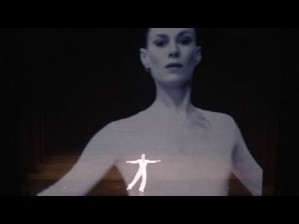
Lucinda Childs is today a reknown figure in postmodern and minimal dance, and also known as one of the founding members of Judson Church. You can check out her profile on wikipedia. Though she should also be remembered for the experiments she did from early on like the remarkable Street Dance Performance. The spectators of the 6 minute piece had been invited to a loft and by listening to a tape, they watched her and another dancer on the street below, at times blending with the everyday street scenario.
With its minimalistic scheme, its use of found materials, and its acceptance of unforeseen interventions, Street Dance exemplifies the early stage of the downtown revolution that came to be called postmodern dance. It could be a way of calling the spectator’s attention to the neglected minutiae of everyday life. It could be thought of as a discipline for the dancers, who had to carry out their tasks unperturbed by the ongoing street life, or as an exercise for the audience in focusing attention, a meditation. But perhaps the most bizarre thing about it was that it introduced the techniques and objectives of art as a natural part of the mundane world, underscoring the messy order that defines city life itself.
(excerpted from: MARCIA B. SIEGEL “Dancing on the Outside”)
Within the dance scene she certainly is best known for her collaborative pieces with Phillip Glass Einstein on the Beach and as well the earlier Dance, which resulted from the interaction of her as a choreographer, Phillip GLass, as a composer and Sol LeWitt , as a visual artist.
Dance now is the first to be on tour in a reworked version and it finally has come to Europe. And it is still a great experience to see. While there can be stated quite some differences to the elder version and the dancers of that time, which is at times superimposed on a translucent screen in front of the stage, it is remarkable how much the piece still stands out. I can imagine the shock it was at its first time to see the dancers in their repetitive, light, flowing and almost playful behavior crossing the area marked as stage, but I am still surprised how resisted the piece is in our times of a kind of ‘higher, wider, faster’ attitude, which now often turns to simple acts of attempted provocation. Thus it is almost shocking in a different sense to such a smart attitude of bodily movement in re/action with that demanding musical score and at the same time as well aligned with a visual impetus of the same level.
| … while the rest of us sat mesmerized by live performers moving behind a scrim with Sol DeWitt’s filmed versions of themselves. Bounding across a white, gridded stage in shimmering skeins of movement |
Lucinda Childs’ landmark work Dance from 1979 – collaboration with composer Philip Glass and visual artist Sol LeWitt, restaged at the Walker Art Center in April of 2011 |
| —hops, skips, leaps, and turns—eight dancers rode the molten ostinato of Philip Glass’s score. Dancers interacted with their images—sometimes larger than life, sometimes blending with them—in an empyrean realm where momentum and design met, fell in love, and engendered a form of undulating math. What made “Dance” so watchable was the juxtaposition of an effortless flow of movement with an austere, almost relentless formality. Think Roger Federer’s casual elegance on the court by way of a corps de ballet’s classic uniformity. This remounted version adds another dimension, as the original film will be superimposed over a different group of dancers. A dance in dialogue with its own history—about as meta-invigorating as it gets. (Linda Shapiro, 2011, citypages) | |
